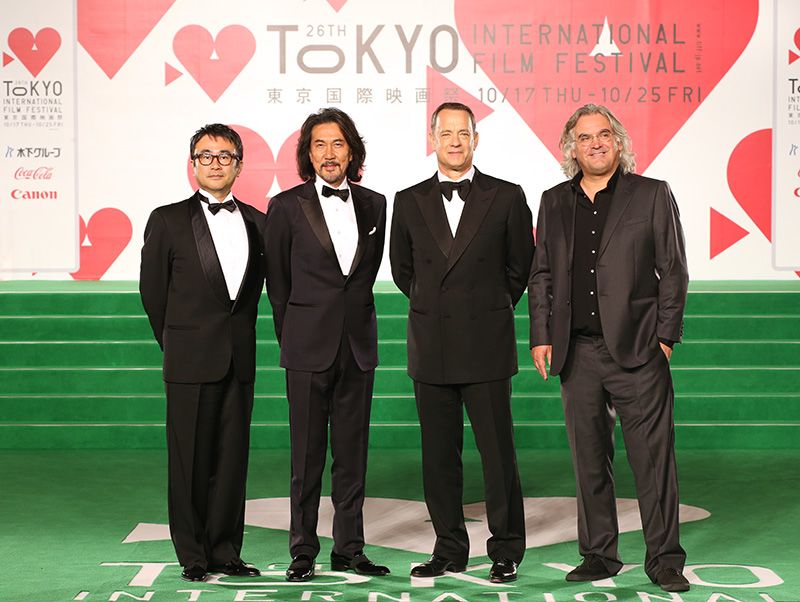
Japanese Cinema's Formula for Success as Seen at the Tokyo International Film Festival
Society Culture- English
- 日本語
- 简体字
- 繁體字
- Français
- Español
- العربية
- Русский
Every autumn, the Tokyo International Film Festival (TIFF) draws film-lovers from across Japan and attracts directors and critics from around the world. It is the nation's most important international film festival—the only one in Japan accredited by the International Federation of Film Producers Associations (FIAPF), and one of the most prestigious in Asia. It was held for the first time in 1985, when director Sōmai Shinji's Typhoon Club received the Grand Prix. Since then, the top award has been won by directors with a wide range of differing styles. Winners include Tian Zhuangzhuang's The Blue Kite (1993), Alejandro Amenábar's Open Your Eyes (1997), and Alejandro González Iñárritu's Amores Perros (2000). The high standard of the festival’s selections is self-evident.
 At the 26th Tokyo International Film Festival in 2013. Globally renowned filmmakers mingle with Japanese actors and actresses on the famous “green carpet.”
At the 26th Tokyo International Film Festival in 2013. Globally renowned filmmakers mingle with Japanese actors and actresses on the famous “green carpet.”
Awards often end up going to the most obvious recipients. In that sense, the most interesting aspect of film festivals is often the drama behind the scenes. A lot of the time, this is generated by the films themselves— particularly those that may lack a wide commercial appeal but are unmistakably attention-grabbing nonetheless. There is always a lot of lively give-and-take between the directors, authors, scriptwriters, and actors, each one out to promote their own works. It is fascinating to eavesdrop on the impassioned conversations that break out near the screening venues regarding individuals' interpretations of the films.
On average, people in Japan perhaps go to the movies less than people in other countries. A large part of the reason must be long working hours: many people don’t leave the office in time to make it to the cinema during the week. But another factor for dwindling audience numbers must be the high price of tickets. No one wants to feel they’ve wasted two hours of their precious free time—and they certainly don’t want to feel they’ve been swindled out of 2,000 yen. As a result, people tend to be very selective when it comes to choosing which films to see.
Interestingly, I’ve found that Japanese film-goers’ priorities are actually quite similar to those of people in other developed countries. Basically, people want films that are easy to understand: they are not necessarily very picky about quality. Nevertheless, what is considered “easy to understand” is not the same in Japan and the United States.
Japanese Films Depend on Everyday Stories
In the United States, box office success is driven by remakes of romantic comedies, superhero sagas, and horror films, as well as an endless repetition of well-rehearsed formulas and genre conventions. In Japan, the most popular stories revolve around everyday life and customs. The Japanese movie industry acknowledges that its productions differ from American fare in terms of quality and depth. In the sense that the film industries in both countries strive to develop mass appeal genres and make maximum use of easy-to-digest archetypes, they ultimately follow the same strategy.
Typically, almost 90 percent of Japanese films are adaptations of novels, manga, and other source material. Even fantasy or science fiction subjects need to convey their worldview and the essential nature of their characters in a recognizably Japanese way. It follows that adapting popular works already familiar in another format is the best way of producing films that audiences will feel an affinity for.
Even a wildly successful film like Departures (2008) was apparently inspired by the book Coffinman: The Journal of a Buddhist Mortician, although this is not mentioned in the credits. Japanese audiences are used to this pattern, and when a book becomes a bestseller people immediately begin to speculate when it will be made into a television series or film.
There are also remakes. Although they are less frequent than in the United States, they are often more audacious. Take Yamada Yōji, the director of almost every installment in the 48-film Tora-san series, for example. His extensive filmography also includes Tokyo Family, which is nothing less than a remake of Ozu Yasujirō's classic Tokyo Story. Yamada's version is a very watchable and well-made piece in its own right. But it is hard to imagine the world's film critics being so understanding if Steven Spielberg announced he was going to remake Citizen Kane.
Can Asian Films Provide Hope for the Global Film Industry at a Time of Crisis?
Even as the global film industry shows signs of decline, Japan continues to produce interesting movies. The same is true elsewhere in Asia, where numerous directors are producing boundary-pushing works that deserve international acclaim. When these films fail to make an impact with critics in other countries, it is often due to cultural differences rather than any intrinsic lack of artistic merit.
One filmmaker whose work deserves a wider international audience is Okita Shūichi. He made audiences laugh with his 2009 film The Chef of South Polar (another adaptation, based on essays by Nishimura Jun), and produced another hit in 2011 with The Woodsman and the Rain, about a film crew shooting a zombie movie in a mountain village. The latter, based on an original screenplay by Okita himself, won a Special Jury Prize at the 24th Tokyo International Film Festival in 2011.
The Tokyo International Film Festival provides an unparalleled opportunity to enjoy a wide array of fascinating films from Japan and around the world. This year’s festival was no exception; the weekend’s films provide precious nourishment for the imagination.
(Originally written in Spanish on October 17, 2013.)